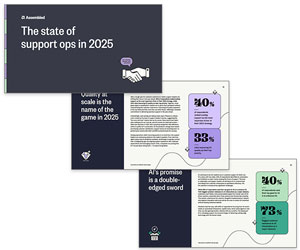Workforce management is difficult enough in an inbound call centre, but when you go outbound it can become a lot more complex.
While the benefits provided by workforce management solutions for an inbound call centre are well known – successfully balancing supply and demand based on achieving or exceeding certain service level standards – the needs of an outbound centre are often very different.
A debt collections operation, for example, is likely to be measured based on the number or monetary value of “promises to pay”. In this instance, achieving a service level goal is much less important than meeting one of productivity.
Outbound Contact Centre Business Challenges
To better understand some of the obstacles outbound contact centres are facing in today’s economic climate, let’s take a closer look at four key business challenges:
1. An increase in operating costs and a decrease in profitability. Losing money is never a good business strategy, but it can be catastrophic in a down economy where cost reductions and revenue generation are of paramount importance. Organisations are demanding that their operations managers exceed established levels of service and productivity, yet with fewer employees and a flat budget. It’s imperative that organisations achieve greater results with the same, or even fewer, employees.
2. A decline in telemarketing and survey activities. According to research conducted by Eurodirect, more than 30 per cent of UK consumers surveyed have noticed a reduction in the overall amount of direct marketing they are receiving. Of those respondents, 17 per cent believe they are experiencing less telemarketing activity. These survey results are a clear indication that organisations are either reducing their marketing efforts or narrowing their target audience in order to maximise their return on their campaign investment.
3. An increase in collections. In tough times, organisations typically see a greater volume of delinquencies, longer delinquency times (e.g. 30 days become 90 days), fewer promises to pay (or lower promise amounts), and an increase in the number of broken promises as consumers struggle to make payments. Collections organisations will also become more persistent in their attempts to collect the debt owed.
4. The unknown impact of imminent customer attrition. Once the financial markets stabilise, customers will be much more likely to “vote with their feet” and leave organisations they believe have failed to understand and appreciate their situation during an economic downturn. The impact from these defections could be sizable, as evidenced by a recent Accenture global survey of business-to-business customer service. Last year around the world an astonishing 30 per cent of companies switched vendors due to poor customer service. As a result, each company lost, on average, roughly £9 million in business.
The Role of Workforce Management In Contact Centres
The role of a workforce management solution is to ensure that you have right people with the right skills at the right time to service customer demand in support of your corporate objectives. These objectives can be very different between inbound, outbound and blended operations, which can lead to very different workforce management decisions.
Forecasting technology is available to predict future demand based on, among other factors, historical call patterns, Erlang and mathematical simulation formulas and seasonality. Typically, agent scheduling is service-level driven to ensure calls are efficiently and uniformly answered throughout the day by the most skilled agent.
The challenge lies, though, in maintaining the right balance between supply and demand – having just enough agents scheduled to handle the anticipated call load whilst maintaining service levels.
Contrary to the inbound contact centre, the outbound contact centre does not function based on service levels or the average speed of answer. The reason? A typical outbound contact centre is highly specialised, making only certain types of calls, such as sales, debt collections, surveys and telemarketing, in the hopes of reaching a specific individual.
Outbound Demand Drivers
As a result, outbound contact centres follow very different demand drivers, such as:
- Per cent of right party connects (RPCs)
- List penetration
- £s per hour collected
- Increased promises to pay
- Increased conversion rates/products per customer
And what will probably come as no surprise is that the best and worst characteristics of inbound and outbound operations come together in a blended environment. Since inbound customer calls naturally take priority over outbound calls, agents who are trained for both inbound and outbound service can easily be redeployed to handle an unexpected increase in inbound demand. Once inbound demand has returned to normal levels, agents can then be redeployed to resume outbound campaign calls. One side effect of the ability to reallocate resources, however, is that blended environments are usually overstaffed in order to meet both worst-case support scenarios in inbound and outbound demand.
Maximising Workforce Management Technology
One of the biggest outbound and blended call centre challenges is to predict the best time to make an RPC (right party connect), and workforce management solutions provide added insight into forecasting outbound needs. To get the biggest bang out of your technology investment, it’s important to maximise your workforce.
By scheduling your best agents when RPCs are known to be at their highest, you will gain maximum efficiency from your workforce, while reducing costs and improving profitability.
Once your workforce is operating at peak efficiency, you should view inbound and outbound elements as a single entity and identify when it’s necessary to cross-utilise appropriate skilled call handlers across inbound and outbound activities.
Forecasting anticipated workload and ensuring competent agents are scheduled to achieve the call centre’s goals are the two most important components of the equation.
Measuring performance to goal and adjusting schedules throughout the day are also key to an effective inbound, outbound or blended call centre strategy.
Thanks to Simon Angove for sharing many of the insights that have been included in this article.
For more insight into WFM over a number of contact centre channels, read our articles:
- How to Forecast and Plan for Live Chat
- How to Work Out How Many Staff You Need in a Contact Centre
- 17 Resource Planning Tools and Techniques You Should Know
Author: Jonty Pearce
Published On: 14th Mar 2010 - Last modified: 13th Aug 2025
Read more about - Workforce Planning, Forecasting, Outbound, Simon Angove, Workforce Management (WFM), Workforce Planning




















